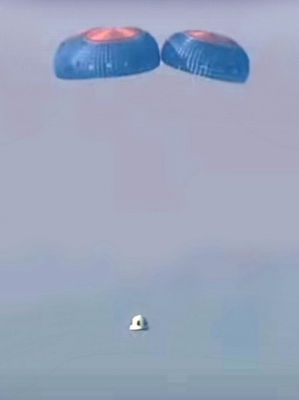
San Francisco, March 25 (IANS) Jeff Bezos’ Blue Origin has blamed the failure of the engine nozzle for an anomaly experienced during the September flight, NS-23, which led the company to abort the mission.
In September 2022, an unpiloted New Shepard faced a dramatic-but-safe in-flight abort, resulting in no danger to human life or property.
All systems designed to protect public safety functioned as planned. There were no injuries, no damage to ground-based systems, and all debris was recovered in the designated hazard area.
Soon after, the company launched an investigation and now it has declared a failure of the BE-3PM engine nozzle during powered flight.
“The direct cause of the NS-23 mishap was a thermo-structural failure of the engine nozzle,” the company said in a statement.
“The resulting thrust misalignment properly triggered the Crew Capsule escape system, which functioned as designed throughout the flight,” it added.
Besides the Blue Origin team, the investigation was conducted with the US Federal Aviation Administration (FAA) oversight and included representatives of the National Transportation Safety Board and NASA’s Flight Opportunities Programme and Commercial Crew Office.
They looked at onboard video and telemetry, flight hardware recovered from the field, and the work of Blue Origin’s materials labs and test facilities.
They also tested the BE-3PM engine and conducted forensic evaluation of the recovered nozzle fragments and found that the nozzle operated at hotter temperatures than previous design configurations. It showed clear evidence of thermal damage and hot streaks resulting from increased operating temperatures, the company said.
The increase in nozzle heating was a result of the design changes made to the engine’s boundary layer cooling system, they noted.
Blue Origin said it is “implementing corrective actions, including design changes to the combustion chamber and operating parameters,” to reduce engine nozzle bulk and hot-streak temperatures.
Additional design changes to the nozzle have also improved structural performance under thermal and dynamic loads.
The company said it now expects to return to flight soon, with a re-flight of the NS-23 payloads.
–IANS
rvt/prw/bg
Related posts:
- WhatsApp may soon let users share high quality photos on iOS beta
- New AI model may soon help doctors diagnose heart attacks accurately
- Food-tech startup Pluckk appoints Mamaearth’s Market Place Head Kunwarjeet Grover as Head of Growth
- 55% of cardiac deaths in India caused by delay in seeking care: Lancet










